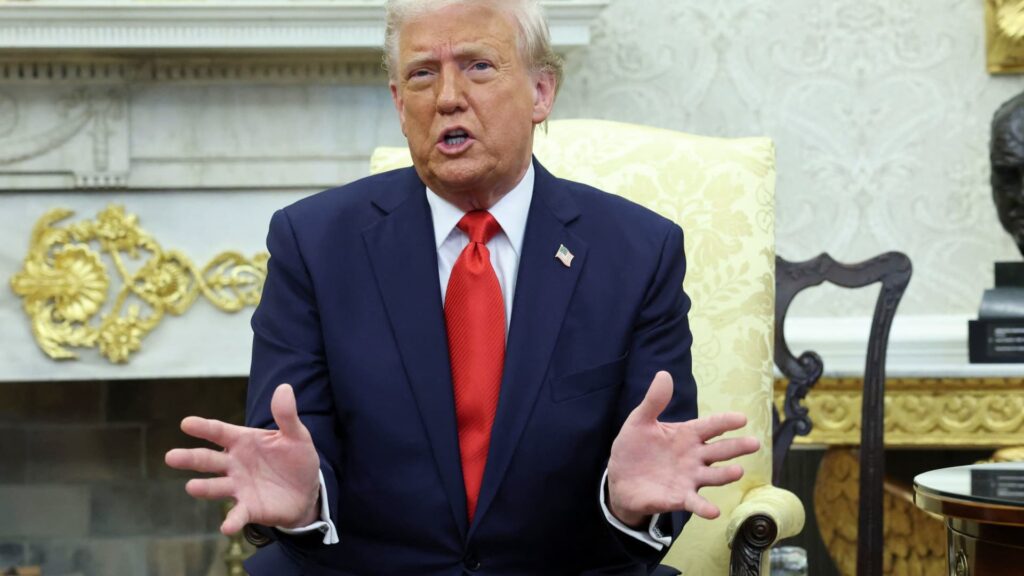
Wall Street Trading Trump Policy Impact: Banks Post Record Revenues Amid Volatility
Wall Street Trading Trump Policy Impact: Banks Post Record Revenues Amid Volatility
Published on April 20, 2025
Wall Street trading desks have seen unprecedented activity as Trump’s policy announcements create market volatility. (Image: Kevin Lamarque | Reuters)
Table of Contents
- Record Trading Revenue: The Trump Policy Effect
- Top Performers: How Major Banks Benefited
- Tariff Policy Volatility Driving Market Swings
- Liberation Day: Market Disruption and Opportunity
- Evolution of Wall Street Trading Operations
- Future Outlook: Will the Trading Boom Continue?
- Regional Banks Left Behind in the Trading Boom
The first months of Donald Trump’s second presidency have triggered unprecedented volatility across financial markets, creating a windfall for Wall Street trading desks as institutional investors scramble to position themselves for a new policy regime. Major banks have reported their highest-ever equities trading revenue in Q1 2025, with Trump policy announcements on tariffs and trade creating market disruptions that have proven highly profitable for financial giants while leaving smaller regional banks struggling.
Record Trading Revenue: The Trump Policy Effect
Major U.S. banks have just posted their biggest-ever haul from stock trading as the opening months of President Donald Trump’s second term led to upheavals across asset classes. The Wall Street trading Trump policy connection has become clear as banks report Q1 earnings that significantly outperformed expectations, driven primarily by their trading operations rather than investment banking activities.
Q1 2025 Wall Street Trading Performance
- Record-Breaking Quarter: The six largest U.S. banks generated $16.3 billion in stock trading revenue
- Year-over-Year Growth: 33% increase compared to Q1 2024
- Historical Context: Higher trading revenue than during previous periods of market disruption, including the 2020 pandemic and 2008 financial crisis
- Analyst Reaction: Performance described as “spectacular,” “extraordinary,” and “awesome” by Wall Street analysts
- Broader Impact: Trading revenue offset weakness in other banking divisions and helped banks beat earnings expectations
The surge in Wall Street trading activity represents a twist on the anticipated Trump boom for financial institutions. While Trump’s second term was expected to primarily benefit investment bankers through increased mergers, acquisitions, and IPO activity, the opposite has occurred. Deal activity has remained tepid, while trading desks have emerged as the biggest beneficiaries of the Trump policy impact on markets.
Top Performers: How Major Banks Benefited
The Wall Street trading Trump policy windfall has not been evenly distributed across financial institutions. The largest banks with sophisticated trading operations have reaped the greatest rewards, with Goldman Sachs, Morgan Stanley, and JPMorgan Chase each generating approximately $4 billion in equities trading revenue during Q1 2025.

Goldman Sachs
CEO David Solomon noted “significant moves in equity markets as people positioned for a different kind of trade policy during March” leading to higher activity. He added that Q2 is already showing strong performance with highly active clients.

Morgan Stanley
CEO Ted Pick, who previously led the transformation of Morgan Stanley’s trading business, stated professional investors have “a lot to play for” as they seek to rack up gains in the volatile market environment.

JPMorgan Chase
While benefiting from strong trading performance, JPMorgan executives have warned their models assume U.S. unemployment will rise to 5.8% later this year, potentially leading to increased loan defaults.
Bank of America also achieved record equities trading revenue, while Citigroup and Wells Fargo rounded out the top six banks that collectively drove the $16.3 billion equities trading haul. While equities traders saw the most substantial gains, fixed income personnel also benefited from higher revenue due to increased activity in currencies, commodities, and bond markets influenced by Trump policy announcements.

Market volatility has spiked with each major Trump policy announcement, creating trading opportunities for Wall Street firms. (Image: Representative)
Tariff Policy Volatility Driving Market Swings
A direct relationship between Wall Street trading revenue and Trump policy announcements has emerged as a defining feature of financial markets in 2025. The cascade of policy changes began immediately after Trump’s January inauguration and has continued to drive market volatility.
Timeline of Trump Policy Announcements Driving Market Volatility
- January 2025: Hours after his swearing-in ceremony, Trump announced imminent tariffs on imports from Canada and Mexico, sending markets scrambling
- February 2025: Escalation of trade tensions with China began, followed by targeting of specific industries including automobiles and steel
- March 2025: A pattern emerged where sweeping tariffs were introduced and then partially scaled back, creating continuous market adjustments
- Early April 2025: “Liberation Day” announcements led to historic market moves, with both equities and government bonds experiencing significant whipsaws
The Wall Street trading Trump policy connection highlights how policy-induced volatility creates both risks and opportunities for financial institutions and investors. Professional money managers, including those at hedge funds, pensions, and other active investment firms, have been forced to constantly reposition their portfolios in response to shifting policy landscapes, generating substantial trading volume and revenue for Wall Street firms.
This statement from Goldman’s CEO underscores how the Trump policy impact extends beyond immediate market reactions to sustained trading activity as investors continuously reassess their positions in light of evolving trade policies and their implications for various sectors of the economy.
Liberation Day: Market Disruption and Opportunity
The most dramatic example of the Wall Street trading Trump policy relationship came in early April with Trump’s “Liberation Day” announcements, which triggered historic market moves as both equities and government bonds experienced exceptional volatility. This period of intense market activity is likely to contribute to even stronger trading revenue in Q2 2025.
Liberation Day Market Impact
The chaotic market environment created by Trump’s Liberation Day policy announcements forced institutional investors to rapidly reposition massive portfolios across multiple asset classes. As markets struggled to price in the implications of sweeping policy changes that were subsequently modified, trading desks at major banks served as critical liquidity providers, capturing wide bid-ask spreads and facilitating essential risk transfers.
This extraordinary period of volatility may actually make Q2 2025 even more profitable for Wall Street trading desks than the record-breaking first quarter, as suggested by comments from bank executives about strong activity continuing into April.
The term “Liberation Day” has now entered the Wall Street lexicon as shorthand for the type of policy-driven market disruption that creates both risk and opportunity for traders. The lessons learned from this period will likely shape how institutional investors and trading desks approach future Trump policy announcements throughout his term.
Evolution of Wall Street Trading Operations
The record-breaking Wall Street trading performance reflects not just market volatility but also the evolution of trading operations since the 2008 financial crisis. Wall Street’s dominant trading desks have transformed their business models to focus more on facilitating client trades and providing leverage rather than taking principal risk.
Modern Trading Desk Advantages
- Industry Consolidation: The financial crisis eliminated competitors like Lehman Brothers and Bear Stearns, concentrating trading and investment banking among fewer, larger firms
- Technological Advancement: Major banks provide ever-faster trade execution and sophisticated risk management tools
- Credit Provision: Larger credit lines enable clients to maintain or increase leverage in volatile markets
- Agency Model Focus: Rather than wagering house money on proprietary bets, modern trading desks profit primarily from facilitating client activity
- Directionless Profit: Today’s trading operations can profit regardless of whether markets rise or fall, benefiting simply from activity levels
Ted Pick, Morgan Stanley’s CEO who previously led the transformation of the firm’s fixed income business and elevated its equities franchise, exemplifies this evolution in Wall Street trading. Under his leadership, Morgan Stanley and other top-tier banks have built trading operations that thrive on volatility rather than being threatened by it.
This statement highlights how modern Wall Street trading desks position themselves as essential service providers during periods of volatility, rather than as speculative risk-takers. The ability to maintain orderly markets while facilitating massive client repositioning has become a key competitive advantage for the largest banks.
Future Outlook: Will the Trading Boom Continue?
The question now facing investors and banking executives is whether the Wall Street trading Trump policy windfall represents a temporary surge or the beginning of a sustained period of heightened market activity. Analysts generally expect elevated volatility to continue as Trump’s policy agenda unfolds.
This outlook suggests that Wall Street trading revenue could remain elevated throughout 2025 and potentially throughout Trump’s term, particularly if his approach to policy announcements continues to create market disruptions. However, several factors could influence this trajectory:
Factors That Could Impact Future Trading Revenue
| Factor | Potential Impact | Probability |
|---|---|---|
| Continued Trade Policy Volatility | Sustained high trading volumes and revenue | High |
| Market Adaptation to Trump’s Style | Gradually declining volatility as investors adjust | Medium |
| Economic Downturn | Initial volatility followed by reduced activity | Medium |
| Revival of Investment Banking | Shift in bank revenue mix toward deals | Low-Medium |
| Regulatory Intervention | Potential constraints on certain trading activities | Low |
The strong Wall Street trading revenue provides an important buffer for major banks as they prepare for potential economic headwinds. JPMorgan executives noted that their models now assume U.S. unemployment will rise to 5.8% later this year, up from 4.2% in March 2025, according to Labor Department data. This deteriorating economic outlook could lead to increased loan defaults, making the trading revenue particularly valuable as a counterbalance.
Regional Banks Left Behind in the Trading Boom
While major financial institutions celebrate record Wall Street trading revenue, regional banks find themselves in a challenging position. Without substantial trading operations, these smaller banks cannot benefit from the volatility created by Trump policy announcements while simultaneously facing the prospect of stagnant loan growth and elevated borrower defaults if economic conditions deteriorate.
Regional Bank Challenges
According to analyst James Shanahan of Edward Jones, regional banks are in a “tough spot” as they lack the diversified revenue streams that are currently benefiting their larger competitors. Their business models remain heavily dependent on traditional lending activities and net interest income, both of which face pressure in the current environment.
If JPMorgan’s economic projections prove accurate and unemployment rises significantly, regional banks may face a double challenge: inability to capture trading revenue upside while being more exposed to credit deterioration in their loan portfolios.
This divergence between the fortunes of major Wall Street institutions and regional banks highlights the uneven impact of the Trump policy environment on the financial sector. While traders at Goldman Sachs, Morgan Stanley, and JPMorgan Chase celebrate record bonuses, smaller financial institutions may face a more challenging path forward.

Modern Wall Street trading operations are designed to thrive in volatile markets, with sophisticated technology and risk management systems. (Image: Representative)
As Wall Street trading Trump policy volatility continues to shape financial markets, the largest banks appear well-positioned to benefit regardless of market direction. Their evolution since the 2008 financial crisis has created more resilient business models that profit from client activity rather than proprietary risk-taking, allowing them to serve as essential market intermediaries during periods of uncertainty.
For investors in banking stocks, this suggests that major financial institutions with significant trading operations may offer greater resilience in the current environment, while those considering regional bank investments should carefully evaluate the potential impact of economic headwinds without the offsetting benefit of trading revenue.
The record Wall Street trading revenue in Q1 2025 may ultimately be remembered as one of the more unexpected consequences of Trump’s return to office—a presidency that was supposed to boost dealmaking has instead created a golden age for traders who thrive on the very volatility that makes corporate leaders hesitant to pursue major strategic transactions.
Published on April 20, 2025 | Updated on April 20, 2025






